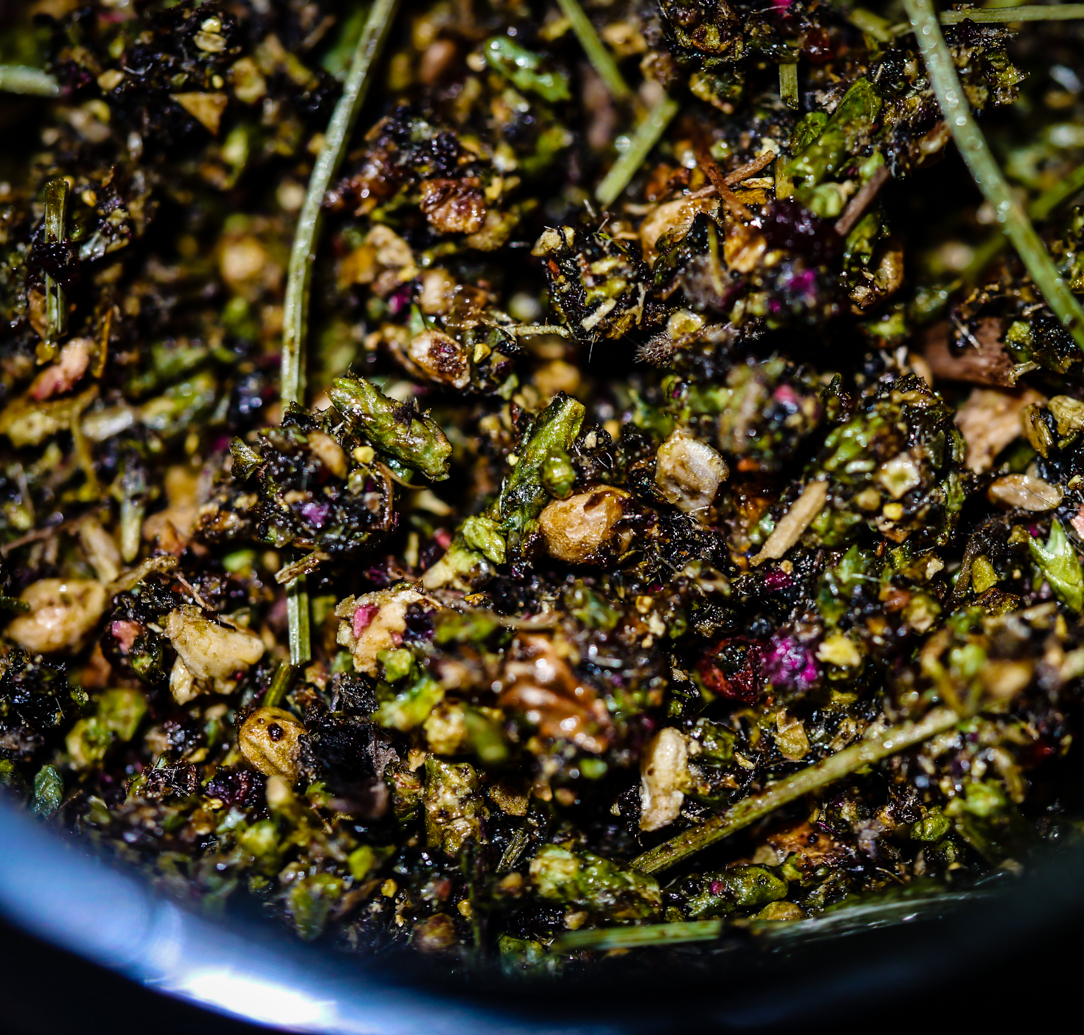fume
Devotions in Smoke
Bioregional Plant Incense
The rising smoke of fragrant plants has long been considered the food of gods and ancestors by humankind. Throughout the centuries, it has retained the connotation of sacred space, magic, and the sensual. Even now, just the description of white smoke rising from an ornate censer can evoke images of ancient temples and forgotten rites. This is no surprise given the power of the olfactory system over memory, dream, and desire.
For the modern American human, however, the word incense may be more likely to bring to mind the suffocating stench of chemical infused headshop fumes than anything sacred, beautiful, or the least bit subtle.
I’ve long loved burning the resins of local conifers on our woodstove during the cold season. I personally far prefer the sweet smoke of a Piñon’s resin to that of any of Frankincense or even Copal. Even the dried leaves of Juniper or Cypress species rank among my favorite smudge or incense scents, far above much more costly, and often exotic, alternatives. When I breathe in the sweet, wild scent from the very trees that make up the forest I live in I’m overwhelmed with gratitude for the many levels of delight and healing they constantly provide me with.
Then I met Sarah Lawless, a Canadian herbalist, who introduced me to the concept of more complex native plant incenses. After smelling the incredibly sweet, complex, and euphoric smoke of her Rocky Mountain and Hawthorn-Rose Kyphi incense she made, I knew I was done for, and had to have more. Sarah’s lovely work also inspired me to create incense from Southwest plants, and more specifically, with the plants of the Saliz and White Mountains of NM and AZ that I so adore. I have to say that these experiments and explorations in the realm of fragrance have been some of my most meaningful when it comes to establishing intimacy with place and gaining a greater understanding of their medicine and magic.
Now first off, before I launch into any recipes, I want to make a quick but important point. That sticky stuff glued to the bark of your local Pine tree. That is NOT sap (or pitch, for that matter). Sap is found deeper inside the tree and transports water, nutrients, hormones, and other vital fluids through the plant. Resin is an immunological secretion used by trees to help protect the plant from potential pests and pathogens, often secreted after the outer surface of the tree has been breached. While I won’t be getting into the deeper, more detailed workings of tree fluids (more on that coming soon) in this article, I feel that understanding the purpose of resin for the tree is important for a couple of reasons. Not least is so that the harvester will understand what the resin produced for, and in turn hopefully realize that it’s very important not to rip large chunks of resin off a wound on a living tree. You then open the tree up to potential infection and could place that tree’s life in danger. My point then, is that it makes the most sense to harvest resin that’s already on the ground or is overflow, not from the actual wound. Another option is to find downed trees or branches and harvest resin from where they are no longer needed.
Types + Technicalities
There are certainly easier types of incense to make than what I like to do, and abundant recipes for them can be found online. I’m writing about this type because I love it so and feel like it could use a bit more exposure so that more people can try it with their own local plants. On the other hand, it can get way more complicated than this, and once you familiarize yourself with the process, it won’t take long at all to get the hang of it and start adapting in many different directions.
The kind of incense I’ll be talking about here will be considered kyphi like to some but does not adhere to any rules or historical recipes. I like it much better than most powdered incenses, and makes a great alternative to loose incense when you feel like mixing things up a bit. I divide my ingredient types up into categories, which makes it easier to come up with a balanced recipe when I know what I need and allows for simpler substitutions as well.
Ingredients
Resins:
Conifer Resin – Pretty much any sort of conifer resin will work here, the hardened is easier to deal with than that which is still soft and gooey. I work with Piñon, Ponderosa, Juniper, Cypress,
Bud Resins – Cottonwoods are the most obvious of these but a number of other trees produce leaf bud resin as well, including Alder, Birch, and some Cherry trees.
Bee Resin – This is simply propolis, the more unrefined the better. Like the other resins, it helps hold everything together and smells wonderful as well.
Leaves & Flowers
Huge number of options here depending on what you’re going for, experiment with a single isolated ingredient and see how it smells when it burns. Figure it’s going to burn way hotter and scorch easier on its own than in the final mix so just go for the general idea. Rose petals, Yarrow leaves/flowers, Douglas Fir needles, White Fir needles, Yerba Santa, all sorts of Sages, Artemisia flowers/leaves, Vervain flowers/leaves, and
Roots & Barks
Orris (a specific species of Iris) root may be the most famous example of roots in incense, but there are many aromatic roots that work well here, including Calamus, aromatic Cyperus species, and Angelica/Lovage/Oshá. Heartwood or bark of Juniper, Cedar, Alder, and many other plants can also add amazing nuances to the incense.
Berries & Berry-Like Objects
Rose hips, Hawthorn haws, Elderberries, and Juniper berries (actually cones) are some of the easiest to come up with but many more dried berries could work here, including Cranberries and Huckleberries.
Infused Honey, Meads, & Wines
Any aromatic honey or fermented honey preparation can work here, or a good wine made from local plants. I’ve used Rose infused honey, Alder/Rose mead, Alder leaf infused honey, Apple mead, Hawthorn infused wine, and many other variations. Infused honeys that are just a bit off, but not growing any strange fuzzy animals (in which in refer to our friendly molds) can work great.
Miscellania
Unrefined beeswax is my main item here, it helps hold things together while smelling nice. Too much will make your incense smell like a guttering candle though.
Proportions & Directions
Now we get to the part where people cuss me for my lack of precise measurements. I hate to tell you this, folks, but I hate measuring shit out. I have to do it in certain situations, as in formulas I use clinically, or when I make botanical perfumes, and in particularly delicate dishes. But not here, here I just go by feel and smell until I find the balance I like. I’ll provide my preference guidelines and you’ll have to figure out what you like best from there.
The thing to keep in mind here is if you don’t add enough resinous material, your incense will scorch and smell burnt much more easily. If you don’t add enough honey/mead/wine you’ll miss out on that sweet, complex flavor that comes with the fermentation and honey. Other than that, it’s pretty hard to mess this up.
You can mix and match endlessly and most likely never get bored, using each opportunity to showcase another dominant scent or scent combo. My most recent batch was Juniper-Cottonwood, and the one before that was White Fir-Rose Hip, and the one before Colorado Blue Spruce-Elderberry-Juniper.
Figure about 1 part resins (conifer resin, propolis, bud resins), 1 part berries, 1/2 part beeswax, 1/2 part roots/bark, and 3 parts leaf/flower, all by (eyeballed) volume.
Grinding Note: I grind all my ingredients by hand in a mortar and pestle. Yes, it would be much quicker and easier in an electric grinder, I just prefer the old fashioned method for this particular project.
I usually start with grinding all my berries an berry like objects up to a rough powder. When I work with Juniper cones, I prefer to roast them lightly beforehand.
I then grind my conifer resins and propolis to a powder and add.
Then I grind my leaves/flowers roughly (larger for things like Douglas Fir needles, more finely for flowers like Rose) and my roots/barks to whatever fineness I can manage by hand in my mortar and pestle.
Next I grate the beeswax.
This all goes in a bowl together, and gets well stirred. And this is very important, because if you don’t get a fairly even coating of resin on everything, you’re going to end up with very inconsistent incense.
I then slowly add the warmed honey/mead/wine until the mix is sticky but not wet.
Then I cover a baking sheet with parchment paper, and put a 1-2 inch thick coating of the mixture on the paper. This part is messy and sticky, prepare to smell good afterwards (and stick to anything you touch).
Next I place the sheet on the cool side of my woodstove wait for the sheet to warm. When the resins start to melt and the whole mess starts to look gooey, I stir and turn the tray slowly round and round until the whole thing is warm and melty.
I then press the mixture flat on the tray again, and put it in a warm (but not hot), dry place to cure/dry for several days to a week.
Once mostly dry (but possibly still a bit sticky-soft), I break or cut into small pieces and store in an airtight container away from light or heat.
Burn on charcoal or a warm (not blazing) wood stove.
Breathe deep.
I don’t consider this to be hard-earned room deodorizer, but rather a very visceral connection to the land and plants. Another form and facet of the plant devotions I discussed in my last post. I treasure every breath taken of the pleasure these plants provide me.

